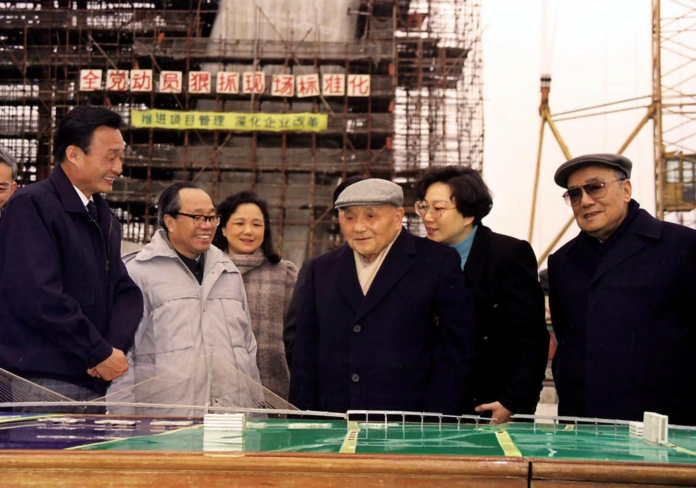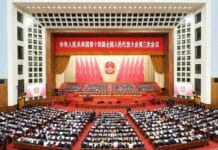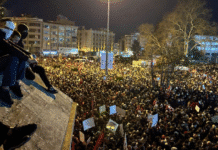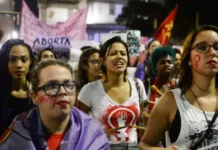A turning point in the restoration of Chinese capitalism
Peter Chan, Socialist Action
On 17 January 1992, Deng Xiaoping boarded a train from Beijing to Shenzhen for a month-long “family trip”. This seemingly unremarkable journey at the time turned out to be a turning point in the process of rapid capitalist development in China. To fully understand the process of the restoration of capitalism in China, it is necessary to understand the history of Deng Xiaoping’s southern tour.
In December 1978, the historic Communist Party Central Committee 3rd Plenum decided to initiate the “reform and opening up” of China. The CCP leaders attempted to save China’s economy by adopting elements of capitalism. This was their “solution” to the deepening problems in China’s Stalinist (i.e. bureaucratic-authoritarian) planned economy, established after the 1949 revolution.
“Feeling the stones”
Initially, Deng and the post-Mao CCP leaders did not have a predetermined blueprint, but rather they experimented with reforms by “feeling the stones to cross the river”. The market reforms, very limited in 1978 compared to what came later, were initially based on the economic policies of the East European Stalinist dictatorships, especially Yugoslavia. Later, with the economic success of the pro-Western capitalist dictatorships in East Asia, the CCP’s attention then turned to the so-called “Four Asian Tigers” (South Korea, Taiwan, Singapore and Hong Kong).
The pro-capitalist reforms were led by Deng’s protégés Hu Yaobang and Zhao Ziyang, who were General Secretary of the CCP and Premier respectively. The reforms at first were mainly carried out through the central government’s initiatives in developing local infrastructure, while decentralising powers to local governments allowing them to make their own economic decisions, including formulating market-oriented policies, retaining profits, accumulating capital, financing (including for foreign trade) and reinvesting.
Four Special Economic Zones (SEZs) were established in the south in 1979 (Shenzhen, Zhuhai, Shantou and Xiamen). By the mid-1980s, Shenzhen had become a symbol of China’s market reforms – local output increased by 29 times between 1980 and 1984 and local GDP per capita was 20 times the national average. However, it was not long before the pro-capitalist reforms or the so-called “Shenzhen Model” saw new problems arise: the emergence of black markets for foreign imports, manipulation of reported investment figures, most of which had domestic sources rather than coming from outside the country, most investment projects were mainly in low-tech industries, and the amount of investment wasn’t sufficient to offset the cost of infrastructure investment from the central government, thus in effect running on “blood transfusions” from the centre.
Inside the CCP a split widened between a pro-bourgeois wing with an increasingly conscious plan to restore capitalism and a conservative wing that wished to maintain the bureaucratically-controlled planned economy. Similar splits developed in every Stalinist regime from Moscow to East Berlin because the Stalinist model was in crisis. They disagreed over which social system and economic policies would best preserve the power and privileges of the ruling group – to remain a privileged bureaucratic caste resting on state ownership (Stalinism) or to convert themselves into a new bourgeois class by dismantling the planned economy (capitalism).
In order to give support and accelerate the pace of reform and to overcome the objections of the CCP conservatives, Deng Xiaoping had to embark on his first southern tour in 1984 to give a stamp of approval to Zhao Ziyang’s market reforms. Soon, the Special Economic Zones expanded to 14 cities, effectively opening the entire coastal region of China.
Student protests
In the second half of the 1980s, the social problems created by the market reforms became more and more apparent. Massive inflow of investment, the dual price system and bureaucratic corruption, led to rising inflation. Discontent began to grow and in 1986 university students across the country protested against corruption and soon also called for political rights and freedoms. The regime conservatives grew alarmed that the reformers’ policies were fuelling demands for greater democratic freedoms.
Hu Yaobang was then removed as CCP General Secretary by Deng, who shared the conservatives’ fears that Hu had been “too lenient” towards the students. Hu was succeeded by his fellow reformer, Zhao Ziyang, however. This was an example of Deng’s Bonapartism: He balanced between social classes and political forces, leaning sometimes one way and sometimes the other way to defeat challenges to his power.
The capitalist economic reforms of the 1980s were a series of zig-zag experiments. In order to solve the problems caused by the dual-price system, whereby some prices were set by the government and others determined by market forces, in 1988 the CCP planned to abolish it and to raise the prices of most commodities in a short period of time. But news of this leaked out and caused panic buying, leading to even worse inflation. Inflation soared from 7.2 percent in 1987, to over 18 percent in the following two years. This was also one of the reasons for the outbreak of the Tiananmen Movement in 1989.
By 1989, the CCP was at the height of internal and external problems. The accumulated contradictions eventually erupted into a potentially revolutionary mass movement centred on an occupation of Beijing’s Tiananmen Square. After the bloody crackdown in June 1989, the West placed sanctions on the CCP regime, while behind the scenes Western governments and especially the US maintained strong diplomatic contacts with Deng’s regime. This led to many foreign investors temporarily stopping investment, while foreign technology exports to China were also restricted. It was during this period of uncertainty that China’s exports fell and the economy was severely affected.
Stalinism’s collapse begins
Internationally, the East European Stalinist bloc began to collapse. This was because as the great revolutionary Leon Trotsky explained, a planned economy needs democratic control by the masses, “like the human body needs oxygen”. Decades of suffocating repressive bureaucratic rule and mismanagement by Stalinism had led to economic stagnation and even regression, with workers’ living standards falling and shortages of many basic items. These so-called communist dictatorships’ use of socialistic terminology to justify their misdeeds discredited socialism among big sections of the population.
In contrast, the misleading impression spread that the capitalist economies of the West were performing well and workers’ living conditions were improving. In the absence of genuine socialist parties that could show a way to fight the bureaucratic dictatorships while at the same time defending the state-owned and planned economic foundations, capitalism was rapidly restored in various countries and Western capitalism triumphantly proclaimed the “end of history”. These developments brought about a serious life-or-death crisis for the CCP regime.
Therefore, doubts about the pace of reform began to grow within the CCP. The conservatives’ position strengthened within the central government. They were led by Chen Yun, who advocated a slowdown in reform and blamed Hu’s reforms for past inflation and crises. However, even Chen Yun did not stand for a return to the old bureaucratic planned economy of Stalinism. Rather, he argued for a slower pace of reform – a decade of reform rather than just a few years – and for avoiding deficit budgets amid fears of inflation if reforms were carried out too quickly, advocating a centralised national plan, supplemented by market reforms.
In fact, as early as late 1988, due to the inflation and the social panic caused by the removal of price controls, the conservatives had already gained the upper hand. To tackle inflation, growth targets were reduced, spending was cut, money supply was reduced, capital and financial controls were centralised and tightened, and attempts were made to rein in the fiscal deficit. As a result, GDP growth was only 4.2 percent in 1989 and 3.9 percent in 1990, which was very low compared to the 9 percent or above annual economic growth that China had maintained since 1982.
During the 1989 revolutionary movement, Deng had to unite with the conservatives and hardliners to suppress the movement, because notwithstanding the limited ‘reform’ horizons of the student leaders, this mass movement had the potential to topple the whole CCP regime. Despite this, Deng still favoured capitalist reforms. Zhao Ziyang was placed under house arrest at the height of the 1989 crisis for opposing the military crackdown. Deng picked Jiang Zemin, the former mayor of Shanghai, to replace Zhao as CCP General Secretary, and later promoted Zhu Rongji, also from Shanghai, to the central government.
Shanghai’s CCP elite was known to be more pro-reform than Beijing’s, a fact that was noted in Washington and helped calm the US capitalists’ nerves. This was clearly understood by the administration of President George H. W. Bush, which despite some tough sounding speeches about human rights was able to allay the fears of American capitalists investing in China that a return to the Stalinist past was unlikely. However, Jiang Zemin’s government was still under pressure from conservatives such as Chen Yun and Li Peng. This period saw the stalling of capitalist policies.
Deng’s Southern Tour
Deng Xiaoping was deeply troubled by the slow pace of the economic transformation. The collapse of Stalinism in Eastern Europe, followed by the Soviet Union in 1991, was a result of the economic crisis which ignited mass discontent. If China’s economy did not develop fast enough, Deng feared the CCP would also collapse like the Soviet Union.
The top-level power struggle became ever sharper. After failing to influence the central government, Deng turned to the local governments for support. In 1991, he first used the local media in Shanghai to advocate more aggressive pro-capitalist reforms. The conservatives at the central level used the People’s Daily to argue against him, which became a heated debate. As other Bonapartist CCP leaders have done, including Xi Jinping, Deng bypassed the official structures in order to get his way.
By the 8th Plenum (of the CCP’s Central Committee) in November 1991, the conservatives still had the upper hand. Then came 17 January 1992, the day Deng embarked on his historic journey to the south. It was a secret mission in the guise of a “family vacation” at the time. Even other leaders of the CCP Central Committee, including Jiang Zemin, were not informed. The CCP’s main newspaper People’s Daily did not send any reporters along with Deng’s entourage. The whole trip was arranged by the pro-reform wing of the military.
Rallying capitalist forces
The journey was not reported by China’s state media at the time, instead it was the well-informed “free” capitalist media in Hong Kong across the border that first brought it to light. Ironically, the relatively greater media freedom in Hong Kong has been crushed by Xi Jinping’s regime today. The purpose of Deng’s tour was to rally support among the local CCP officials, who had gained much from the capitalist reforms in the 1980s and therefore would be his natural supporters. Deng’s aim was to mobilise the country’s rising bourgeois class in the local governments and force the central government to comply.
After arriving in the southern province of Guangdong, Deng met with local officials and inspected different development projects. Although he did not openly criticise the central government, it was clear there was a hidden message. He complained of “too many meetings and too many long speeches”, that there should be “more practical work and less empty talk”, and that “whoever does not reform will have to step down”.
Deng also maintained that “China should be wary of the right but mainly guard against the left”. The so-called “right” refers to the liberal political reform wing of the CCP, which were suppressed after the massacre in 1989. And “left” according to Deng was the conservative or quasi-Maoist wing that was still sceptical in its attitude towards capitalism. By this time, all wings of the CCP regime had abandoned the planned economy and saw capitalism as something inevitable. They differed only on the speed and scale of so-called reform (capitalism), with various cliques also fighting to safeguard their own sectional economic interests within this process.
Elements of a coup
The covert nature of the trip, to rally local officials against the policies of the central government, meant the Southern Tour was an extremely sharp power struggle within the CCP, with its long history of internecine conflicts, and even had elements of a coup. In fact, during the trip Deng did weigh up the possibility of staging a military coup.
According to Ezra F. Vogel’s biography of Deng, during the tour he organised a secret meeting in Zhuhai with top military officials. This meeting has never been reported in the official histories published by the CCP because they do not want to admit to such a sharp internal power struggle. Other participants at the meeting included Qiao Shi, member of the Politburo Standing Committee; Yang Shangkun, nominal President of China and the First Vice-Chairman of the Central Military Commission, who held de facto military power; General Liu Huaqing, Vice-Chairman of the Central Military Commission; and General Yang Baibing, Yang Shangkun’s younger brother and Secretary General of the Central Military Commission and Director of the General Political Department.
At this meeting Deng reiterated, “Whoever doesn’t reform will have to step down … Our leaders look like they’re doing something, but they’re not doing anything useful.” The strong representation of military leaders at this meeting was its decisive feature. Jiang Zemin, who had no real power in the military, did not participate. Instead it was Qiao Shi, seen as a potential challenger for Jiang’s job, who attended. This indicated that the army was ready to support a new leader to push for reform if necessary.
Upon receiving the news in Beijing, Jiang quickly realised the balance of power had changed. He then decisively sided with Deng Xiaoping and ordered that Deng’s speeches during his Southern Tour be compiled into party documents and made mandatory reading for the central leadership. All of a sudden, the atmosphere within the CCP changed. “If there was any doubt in the aftermath of the Tiananmen Square massacre about the commitment of the Chinese leadership to economic reform, it was definitely dispelled in 1992,” noted American China expert Elizabeth J. Perry.
At the 14th CCP Congress held in October 1992, Jiang Zemin proposed that the goal of China’s economic reform was to establish a “socialist market economy”, a term invented by Jiang with Deng’s blessing to replace Chen Yun’s term of “planned socialist market economy”. At the congress, Jiang announced a GDP target of 8-9 percent, much higher than the 6 percent announced by Li Peng earlier that year. At the same time, the Central Advisory Committee was abolished and its director Chen Yun, the main ideologue of the conservatives, retired.
Counter-revolution is a process
The Southern Tour can be seen as a decisive turning point in the struggle for power within the CCP, as the new capitalist class around Deng secured complete dominance, not as an outside force, but as an integral component of the CCP dictatorship. China’s reform and opening was in fact not at all a process of “reform” but of capitalist counter-revolution: a series of blows aimed against the old planned economy which cleared the way for the growth of today’s super-rich capitalist class and the eradication of the remaining social gains from the era of planning.
There was more than one turning point in this process of counter-revolution. 1989 was a turning point in that it removed the threat of mass resistance. This was achieved by the CCP’s extremely brutal suppression of the incipient workers’ democratic revolution (political revolution) against authoritarian rule and, despite lacking a clear program, against the advancing capitalist counter-revolution of the CCP’s “reformers”. 1992 was another turning point, which broke the last pockets of resistance within the CCP regime to Deng’s line of rapid capitalist development within the framework of an autocratic regime, without any concessions to liberal capitalism’s political reform agenda.
Since then, the CCP followed the road of high-speed capitalist development without major controversy for over 20 years. In the mid-1990s Jiang Zemin and his premier Zhu Rongji presided over massive privatizations of state-owned enterprises (SOEs) under the policy of “Grasp the Large, Let Go of the Small”. In 1998, the property sector was privatized in a big bang, which laid the foundations of today’s ultra-speculative and unaffordable housing market. 60 million SOE employees were terminated in the late 1990s to pave the way for China’s WTO membership in 2001. Such brutal pro-rich policies continued and accelerated during the rule of Hu Jintao and Wen Jiabao (2002-12).
This stage continued until the global capitalist crisis of 2008 and the rise of Xi Jinping in 2012. The catastrophic failings of capitalism were exposed in the 2008 crisis, which forced governments around the world to look to more state intervention, regulation, and to turn from globalization to economic nationalism. The CCP too began to shift to more state capitalist controls – a signature feature of Xi’s rule. This does not of course mean a return to Stalinist “socialism”, something that is neither possible nor desirable for a capitalist regime like today’s CCP, but rather looking for measures to rein in capitalism’s destructive forces in an attempt to achieve capitalist “stability”.




